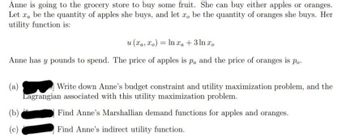
ENGR.ECONOMIC ANALYSIS
14th Edition
ISBN: 9780190931919
Author: NEWNAN
Publisher: Oxford University Press
expand_more
expand_more
format_list_bulleted
Question

Transcribed Image Text:Anne is going to the grocery store to buy some fruit. She can buy either apples or oranges.
Let a be the quantity of apples she buys, and let zo be the quantity of oranges she buys. Her
utility function is:
u(xa, xo) = ln xa + 3 ln xo
Anne has y pounds to spend. The price of apples is pa and the price of oranges is po
(a)
(b)
Write down Anne's budget constraint and utility maximization problem, and the
Lagrangian associated with this utility maximization problem.
Find Anne's Marshallian demand functions for apples and oranges.
Find Anne's indirect utility function.
Expert Solution
This question has been solved!
Explore an expertly crafted, step-by-step solution for a thorough understanding of key concepts.
This is a popular solution
Trending nowThis is a popular solution!
Step by stepSolved in 2 steps with 2 images

Knowledge Booster
Learn more about
Need a deep-dive on the concept behind this application? Look no further. Learn more about this topic, economics and related others by exploring similar questions and additional content below.Similar questions
- Utility maximization under constraint, substitution and income effect, CV and EV Josh gets utility (satisfaction) from two goods, A and B, according to the utility function U(A, B) = 4[A-4 + B-4-4 + 40. While Josh would like to consume as much as possible he is limited by his income. a. Maximize Josh's utility subject to the budget constraint using the Lagrangean method b. Suppose PA increases. Show graphically the income, substitution effect and total effect and explain c. Suppose PA increases. Show the graphs for CV and EV and explain. One graph for CV and one graph for EVarrow_forward3*. Ms Smith likes to drink wine; in particular, a french bordeaux (f) at $40 per bottle and a California varietal wine (c) priced at $8. She allocates $600 to these two each month; and her utility is: U(ƒ, c) = ƒ²/³ c¹/³ (a) Write out her (constrained) utility maximization problem. Solve for the optimal consumption of wine f and c.arrow_forwardHelp!arrow_forward
- A consumer has a utility function given by lnU =5linx subscrip1 +3lnx subscript 2 if the budget constraint is given by 10x subscript 1 +14x subscript 2 =124 find the optimal quantity of the two commoditiesarrow_forwardRicky has utility function u=x'y. This implies that MUx=2xy. MUy=x². His income is 100. The price of y is 10. (a) Find his demand for x at price 20. (b) Find his demand for x at price 30. (c) Write down his demand function for x: that is, write down his demand for x as a function of the price of x.arrow_forwardA consumer has utility (see image) on ice creams (x) and cakes (y). (a) Are the indifference curves bowed towards the origin? (b) Derive his demand function (as a function of prices px, py and budget I) for ice cream (x). (c)(Looking at the demand function you found in (b), Is ice cream a normal good? Are ice cream and cakes substitutes or complements? Calculate the income elasticity of market demand at the point px = 2, py = 1 and I = 12.arrow_forward
- Only typed solutionarrow_forward3) The utility function of a consumer who consumes quantities x and y of two goods is defined by the expression U(x, y)=√xy subject to the constraint 7x+3y=84 where $84 is the consumer's overall budget. Assuming marginal utilities U,,U>0, maximize the utility function of the consumer. What are the optimal values of x, y and U(x,y) ?arrow_forward6. Consider a consumer with the utility function u(x,, x2) = In(x,) + x2 and the budget constraint p, x, + PP2X2 = m. Derive the consumer's demand functions for x, and x2.arrow_forward
arrow_back_ios
arrow_forward_ios
Recommended textbooks for you

 Principles of Economics (12th Edition)EconomicsISBN:9780134078779Author:Karl E. Case, Ray C. Fair, Sharon E. OsterPublisher:PEARSON
Principles of Economics (12th Edition)EconomicsISBN:9780134078779Author:Karl E. Case, Ray C. Fair, Sharon E. OsterPublisher:PEARSON Engineering Economy (17th Edition)EconomicsISBN:9780134870069Author:William G. Sullivan, Elin M. Wicks, C. Patrick KoellingPublisher:PEARSON
Engineering Economy (17th Edition)EconomicsISBN:9780134870069Author:William G. Sullivan, Elin M. Wicks, C. Patrick KoellingPublisher:PEARSON Principles of Economics (MindTap Course List)EconomicsISBN:9781305585126Author:N. Gregory MankiwPublisher:Cengage Learning
Principles of Economics (MindTap Course List)EconomicsISBN:9781305585126Author:N. Gregory MankiwPublisher:Cengage Learning Managerial Economics: A Problem Solving ApproachEconomicsISBN:9781337106665Author:Luke M. Froeb, Brian T. McCann, Michael R. Ward, Mike ShorPublisher:Cengage Learning
Managerial Economics: A Problem Solving ApproachEconomicsISBN:9781337106665Author:Luke M. Froeb, Brian T. McCann, Michael R. Ward, Mike ShorPublisher:Cengage Learning Managerial Economics & Business Strategy (Mcgraw-...EconomicsISBN:9781259290619Author:Michael Baye, Jeff PrincePublisher:McGraw-Hill Education
Managerial Economics & Business Strategy (Mcgraw-...EconomicsISBN:9781259290619Author:Michael Baye, Jeff PrincePublisher:McGraw-Hill Education


Principles of Economics (12th Edition)
Economics
ISBN:9780134078779
Author:Karl E. Case, Ray C. Fair, Sharon E. Oster
Publisher:PEARSON

Engineering Economy (17th Edition)
Economics
ISBN:9780134870069
Author:William G. Sullivan, Elin M. Wicks, C. Patrick Koelling
Publisher:PEARSON

Principles of Economics (MindTap Course List)
Economics
ISBN:9781305585126
Author:N. Gregory Mankiw
Publisher:Cengage Learning

Managerial Economics: A Problem Solving Approach
Economics
ISBN:9781337106665
Author:Luke M. Froeb, Brian T. McCann, Michael R. Ward, Mike Shor
Publisher:Cengage Learning

Managerial Economics & Business Strategy (Mcgraw-...
Economics
ISBN:9781259290619
Author:Michael Baye, Jeff Prince
Publisher:McGraw-Hill Education